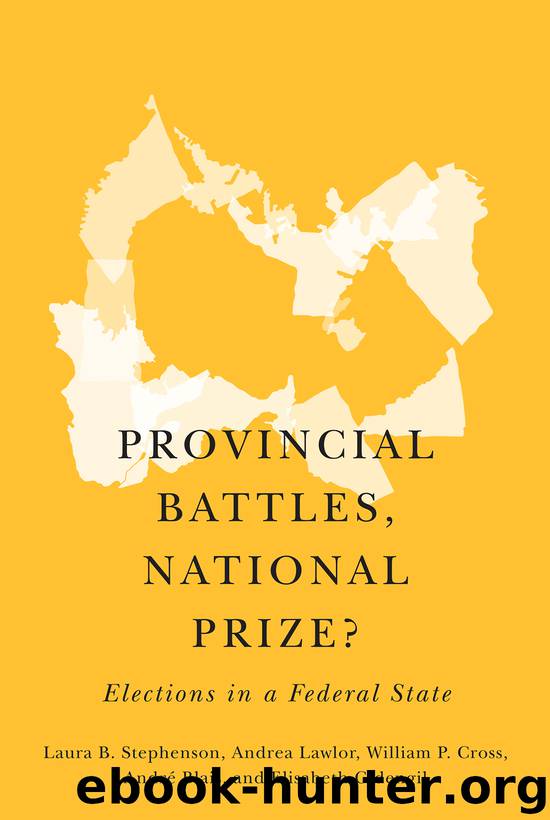Provincial Battles, National Prize? by Laura B. Stephenson

Author:Laura B. Stephenson
Language: eng
Format: epub
Publisher: MQUP
Published: 2019-08-21T16:00:00+00:00
Figure 6.1 Proportion of coverage type (print news)
Considering the discussion in chapter 5, it is not surprising that the economy appears to have dominated news coverage of the campaign. It was by far the most common subject of the leaders’ events and was also at the top of the list of issues discussed in the parties’ press releases. Interestingly, the Conservative’s emphasis on tax policy is not reflected in the newspapers’ campaign coverage.
Figure 6.2 Coverage by province (print news)
Turning to broadcast news, figure 6.3 shows the number of issue mentions by city. What is immediately obvious is that social policy (including health care, education, and family-related policies) dominated televised coverage of the campaign. Given the focus on economic issues in the newspapers, leaders’ events, and party press releases, this finding is striking. We suspect that it reflects the different audiences for each type of media. Social policy issues may be more central to the considerations that inform television viewers’ votes. At the same time, the nature of social policy coverage may be more relatable than coverage of economic issues and might lend itself to short, pithy soundbites and visuals that work well in televised news.
The economy is the second-most covered issue in all three cities, but there is variation in the amount of coverage from city to city for the remaining issues. Crime and taxes were covered more often in Vancouver while security and taxes received more coverage in Toronto. In Montreal, taxes, security, the refugee crisis, the environment, and democratic reform all received a significant amount of coverage. In both Toronto and Montreal, though, coverage of these issues trailed far behind social policy and the economy. Overall, then, the results show that there is less variance across provinces than there is across media types. Someone who consumes only television news (from CTV, at least) would have a different understanding of key issues in the election than someone who only reads newspapers.
How does the coverage of issues in both media types compare to actual campaign events? Clear variation could indicate active behaviour on the part of the media to set the agenda for the election. Figure 6.4 presents data about newspaper coverage and assuages this concern, as coverage of the issues responded to happenings in the campaign. For example, the prominence of the Duffy trial in the early days of the campaign reflects the timing of Nigel Wright’s testimony, and the spike in coverage of the refugee crisis at the beginning of September followed the release of the photo of Alan Kurdi on 3 September 2015. Similarly, coverage of trade surged far later in the campaign as news coverage was dominated by discussions of the Trans-Pacific Partnership agreement early in October. The debate over the proposed ban on wearing the niqab during citizenship ceremonies re-emerged after the Supreme Court refused the government’s appeal on 15 September.
The same events prompted spikes in coverage in all three provinces, but how strongly the press responded varied depending on the issue and the province.
Download
This site does not store any files on its server. We only index and link to content provided by other sites. Please contact the content providers to delete copyright contents if any and email us, we'll remove relevant links or contents immediately.
| Anthropology | Archaeology |
| Philosophy | Politics & Government |
| Social Sciences | Sociology |
| Women's Studies |
The Secret History by Donna Tartt(18236)
The Social Justice Warrior Handbook by Lisa De Pasquale(11964)
Thirteen Reasons Why by Jay Asher(8476)
This Is How You Lose Her by Junot Diaz(6463)
Weapons of Math Destruction by Cathy O'Neil(5855)
Zero to One by Peter Thiel(5508)
Beartown by Fredrik Backman(5373)
The Myth of the Strong Leader by Archie Brown(5250)
The Fire Next Time by James Baldwin(5034)
How Democracies Die by Steven Levitsky & Daniel Ziblatt(4972)
Promise Me, Dad by Joe Biden(4916)
Stone's Rules by Roger Stone(4875)
100 Deadly Skills by Clint Emerson(4701)
A Higher Loyalty: Truth, Lies, and Leadership by James Comey(4568)
Rise and Kill First by Ronen Bergman(4554)
Secrecy World by Jake Bernstein(4407)
The David Icke Guide to the Global Conspiracy (and how to end it) by David Icke(4398)
The Farm by Tom Rob Smith(4332)
The Doomsday Machine by Daniel Ellsberg(4254)
